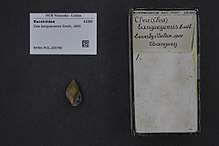Clea bangueyensis
Clea bangueyensis[1] is a species of freshwater snail with an operculum, an aquatic gastropod mollusk in the family Buccinidae, the true whelks, most of which are marine.[2][3]
| Clea bangueyensis | |
|---|---|
 | |
| Clea bangueyensis shell | |
Not evaluated (IUCN 3.1) | |
| Scientific classification | |
| Kingdom: | |
| Phylum: | |
| Class: | |
| (unranked): | |
| Superfamily: | |
| Family: | |
| Genus: | |
| Subgenus: | |
| Species: | C. bangueyensis |
| Binomial name | |
| Clea bangueyensis Smith, 1895 | |
Feeding habits
Like all snails in the clade Neogastropoda, this species is carnivorous. It feeds on different types of worms and gastropods. These predatory snails often attack and eat other, larger snails by burying themselves and then ambushing their prey.[3]
Reproduction
Clea bangueyensis consists of defined male and female genders, and are not capable of gender change. It is unknown as to how to sex these animals. Both male and female seem to be the same size and shape. When a male and female mate, they lock together for eight to twelve hours.
gollark: It can, apparently, be used to violate copyright by downloading things off YouTube.
gollark: Idea: DMCA all Turing-complete languages with network I/O capabilities, which can technically be used to violate copyright.
gollark: The project could just selfhost gitlab or something.
gollark: China would probably also be bad but in different ways.
gollark: I think the main thing is just that you should have "resources" at nice URLs and use HTTP methods and such.
References
- "Clea bangueyensis". Catalogue of Life. ITIS. Species 2000.CS1 maint: others (link)
- Bouchet, P.; Fraussen, K. (2013). "Clea – H. Adams & A. Adams, 1855". World Register of Marine Species. Retrieved March 4, 2014.
- Monks, Neale (2009). "Assassin Snails and Sulawesi Elephant Snails: Keeping Clea and Tylomelania in the aquarium". Conscientious Aquarist Magazine. Retrieved March 11, 2014.
Clea are whelks, most of which live in the sea. Like their marine relatives, Clea are opportunistic carnivores that feed on both live prey and carrion. Among the prey taken are snails, and it is this that has made them popular with fishkeepers. Clea stay partially hidden under the sediment, and if a snail slides past, then quickly (by snail standards) jump into action, chasing their prey and eventually subduing it.
This article is issued from Wikipedia. The text is licensed under Creative Commons - Attribution - Sharealike. Additional terms may apply for the media files.